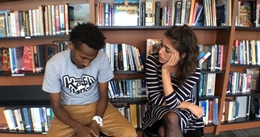 Two-by-Ten strategy
Two-by-Ten strategy
From an article by ASCD
Mahad was a newly enrolled 11th grade student at our school in San Diego. He left class whenever he wanted to. He was on his phone a lot. He yelled out to other students in the middle of class. And he was failing all of his classes, having done none of the work during his first few weeks of attendance. A quick review of his cumulative files from his previous schools showed multiple suspensions, disciplinary actions, and failing grades. He was at risk for becoming a statistic, and not a good one.
Instead of taking drastic measures, Mahad's teaching team decided to give him three weeks of leeway, hoping that each day would get better. Marisol Thayre, Mahad's English teacher, began to build a relationship with him through a systematic process called Two-by-Ten—an adult interacts with the student in relationship-building conversations for 2 minutes a day for 10 consecutive days.
In several conversations that happened during those first few days, Ms. Thayre had asked about Mahad's aspirations, saying, "Who do you want to be and what do you want to be?" Mahad had talked a bit about wanting to be respected and mentioned that he wanted to make enough money to support his family. In one of those conversations, the two also used a sentence frame to share one fact at a time about themselves. Taking turns, each of them completed the sentence "If you knew me, you would know ____." After several exchanges, Ms. Thayre completed the sentence by saying that her dad had died the year before. Mahad teared up, revealing that his dad had died as well.
Ms. Thayre uses her emerging relationship with Mahad to let him know that she has noticed his actions and that she expects him to behave differently. She doesn't scold him, punish him, or threaten to send him to the vice principal. Instead, she solicits his input in addressing the situation.
Ms. Thayre approaches Mahad in the role of problem-solver rather than disciplinarian. She asks him to help her find ways she can support him in altering his behaviour. She shares parts of her life with Mahad and learns a little about him. When you know someone's story, you see them in a different light, and it's hard to be disrespectful to them.
Over time, we see Mahad begin to respond, seeking out Ms. Thayre to tell her about his internship experience and offering a solution for how he and Ms. Thayre can navigate his difficult moods. They agree to implement his idea—that he move to a separate part of the classroom when he's too distracted or upset to participate—and it works. Ms. Thayre's role changes as she begins to broker relationships between Mahad and his other teachers, often meeting with another teacher and Mahad together. She offers Mahad advice about the actions he can take to become the person he says he wants to be.
The Two-by-Ten strategy
Raymond Wlodkowski, then Professor and Director of the Center for the Study of Accelerated Learning at Regus University, Denver, did extensive observations of student behavior, cataloguing student time in and out of seat as well as the types, instances, and severity of student disruptions. In particular, he researched a strategy called "Two-by-Ten." Here, teachers focus on their most difficult student. For two minutes each day, 10 days in a row, teachers have a personal conversation with the student about anything the student is interested in, as long as the conversation is G-rated. Wlodkowski found an 85-percent improvement in that one student's behaviour. In addition, he found that the behaviour of all the other students in the class improved.
Martha Allen, an adjunct professor at Dominican University's Teacher Credential Program in San Rafael, California, asked her student teachers to use the Two-by-Ten Strategy with their toughest student. The results? Almost everyone reported a marked improvement in the behavior and attitude of their one targeted student, and often of the whole class. Many teachers using the Two-by-Ten Strategy for the first time have had a similar corroborating experience: Their worst student became an ally in the class when they forged a strong personal connection with that student.
This can be counterintuitive. But the students who seemingly deserve the most punitive consequences we can muster are actually the ones who most need a positive personal connection with their teacher. When they act out, they are letting us know that they are seeking a positive connection with an adult authority figure and that they need that connection first, before they can focus on learning content.
"Not only does Two-by-Ten help with the toughest students," says Paul Kilkenny, a teacher mentor in San Jose, "but also it helps the teachers remember their humanity as they attempt to survive and thrive in the classroom."
Read the full article and watch a video of conversations here.
Retweet about this article:
From an article by ASCD, 10/07/2019